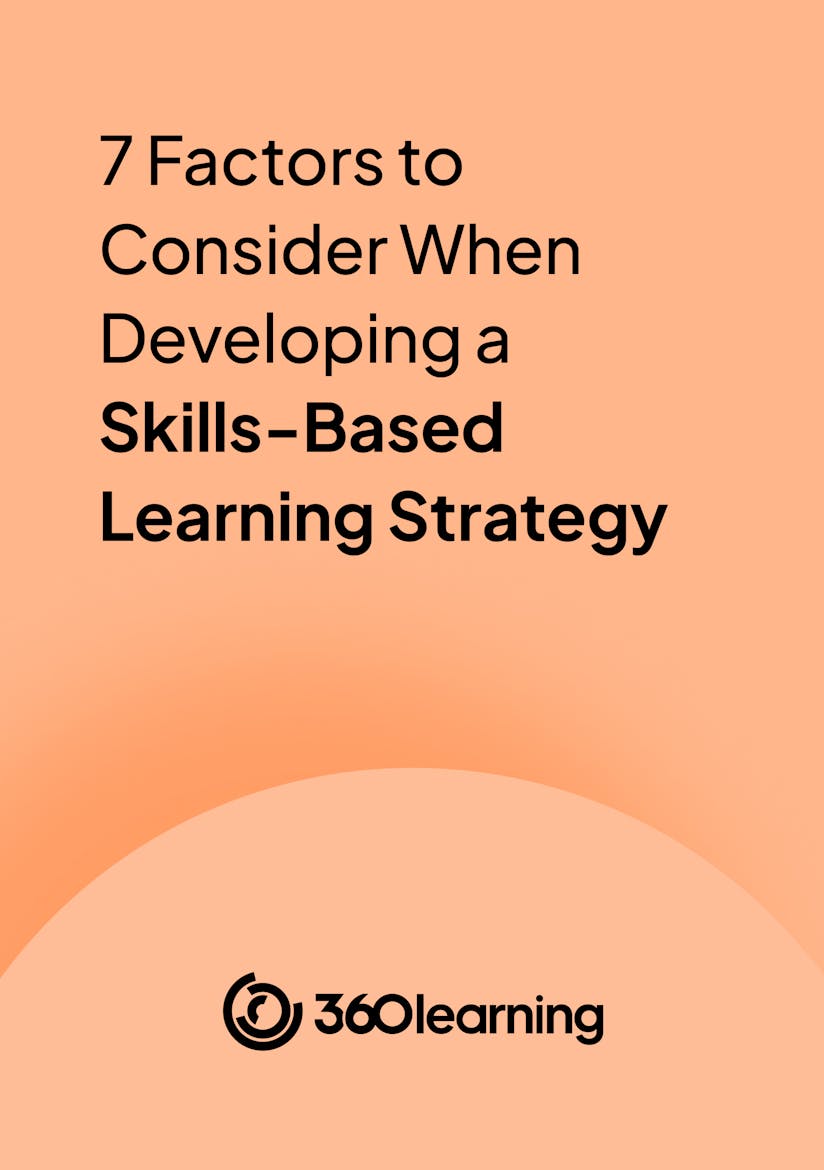

Training & Learning
Four Steps for Implementing Enterprise-Wide Skills-Based Learning with Ryan Tracey
Although there has yet to be a better time to be in L&D, we need to ensure that our function is grounded in the practical realities of our employees and business needs.
As a profession, we need to identify the gap between what people are expected to do and what they are currently doing, close that gap, and ensure that our ground zero for measurement is assessing people's capabilities today.
In this article, with insights from Ryan Tracey, Capability Development Manager, we explore four practical steps for implementing skills-based learning at an enterprise level, how to prove impact by measuring skills uplift, and four tips to help you get your skills strategy off the ground.

Guarantee a successful move to skills-based L&D
By providing your contact info, you agree to receive communications from 360Learning. You can opt-out at any time. For details, refer to our Privacy Policy.
Skills-based learning is about what people do
Skills-based learning focuses on developing the abilities of employees to do their jobs and increase performance.
Ryan holds an organization-wide definition and, for that reason, likes Gabe Gloege’s anti-definition of skills-based learning: skills-based learning is not about role-based learning but rather transferable skills that are applicable in any role.
In his blog, Ryan also adds another definition: skills-based learning isn’t knowledge-based learning. Instead of focusing on what employees know, you should focus on what they do.
“It is important to recognize that these semantic exercises aren’t necessarily right or wrong; they are just different lenses through which we view learning and development,” says Ryan.
"These semantic exercises aren’t necessarily right or wrong; they are just different lenses through which we view learning and development,” - Ryan Tracey.
Four steps to enterprise-wide skills-based learning
With over 20 years of experience, Ryan has developed four steps to help you get your skills-based learning approach up and running.
Step two
Once you’ve identified the skills you will target, you need to assess your current state.
“I like to call it a skills census, and it doesn’t have to be complicated,” says Ryan.
“I like to call it a skills census, and it doesn’t have to be complicated."
For example, you can leverage self-rated confidence indicators. Although imperfect, they are great for quickly assessing your organization's current state.
Step three
Identify your high-priority skills from an enterprise-wide framework of about nine or ten skills—don't overwhelm yourself with thirty or fifty skills.
“Identify your high-priority skills among those nine or ten skills, maybe two or three. Those are the ones you double down on as an L&D team,” says Ryan.
Step four
Shift your focus to how you will develop the skills across the organization.
A great approach is to build end-to-end learning experiences that are worthwhile for employees and to ensure you get your return on investment.
Expected complication of enterprise skills-based learning
A significant challenge with skills-based learning on an enterprise scale is deploying your upskilling experiences across different geographical locations.
A great way to address this challenge is to build out blended learning experiences. Digital learning is flexible and self-paced and great for facilitating content consumption upfront.
Next, follow up with a live session, in-person or virtual, to focus on value-added activities like peer-to-peer interactions to contextualize the digital content. Try to facilitate the practical application of the knowledge under supervision with expert feedback.
“Remember that skills are about doing, and the design of the learning experience needs to address that,” says Ryan.
“Remember that skills are about doing, and the design of the learning experience needs to address that."
Measure the uplift of skills to prove impact
To prove the impact of our upskilling learning experiences, we need to shift our focus toward measuring the uplift of the targeted skills.
“For that, I have used pre- and post-assessment, monitoring the number of badges earned, looking at the uptick in your skills census, and seeing if there is any impact from an organizational point of view,” says Ryan.
Certifications and badges can validate the targeted skill. These need to be genuine and represent an evidence-based assessment of practice—not just a shiny little picture. The badges must show that people have applied that skill in the workflow.
To solve the challenge of measuring soft skills, which are very hard to measure at scale, Ryan deploys showcases. These are events where people who have completed a learning experience share how they have applied the skill in real life and the resulting outcomes.
Four tips: Implementing enterprise-wide skills-based learning
Ryan has four tips to help you implement a skills-based strategy today.
1. Lead from the front: If skills-based learning isn't already an approach in your organization, start today.
“You’re not breaking any rules by doing skills-based learning. At least behind the scenes, you can start implementing a skills-based strategy now,” says Ryan.
“You’re not breaking any rules by doing skills-based learning. At least behind the scenes, you can start implementing a skills-based strategy now."
2. Keep your skills framework organic: Evolve your skills framework as an organic document to keep pace as your organization’s business strategy changes.
3. Resist adding more new skills: Focus your energy on what matters most by ruthlessly prioritizing your skills and sidelining unnecessary ones.
4. Again, start today: Launch your skills-based learning experiences sooner rather than later. Start with a good enough learning experience to start showing value now.
“You don’t want to be that organization that waited two years or more before launching skills-based learning,” says Ryan.
Explore further insights on skills-based learning on the episode of The L&D Podcast: Enterprise-Wide Skills-Based Learning with Ryan Tracey
Want more peer insights on transforming workplace learning? Sign up to become a member of the L&D Collective. Or you can subscribe below to our weekly newsletter to receive our latest posts directly in your inbox.



